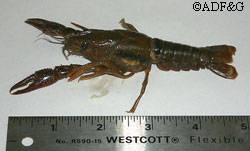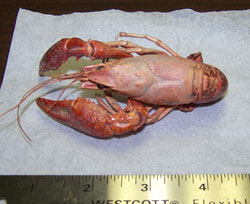Alaska Fish & Wildlife News
April 2008
Invaders from the Bayou
Be Careful with Crawfish

“King salmon….king salmon….king salmon…..crawfish???”
The king salmon netting crew for the Division of Sport Fish spends a lot of time sampling fish on the Kenai River during the busy summer months, and they are used to catching a lot of fish. Imagine their surprise, though, when last summer they pulled a crawfish from their gillnet.
Of all of the aquatic animals that could be collected in a gillnet on the Kenai River, crawfish are some of the least likely. Why? Because they do not naturally occur in the Kenai River or any other river in Alaska. Unfortunately, crawfish have been collected from the lower Kenai River twice in the last four years, and both times they were leftovers from someone’s dinner.
Traditional Cajun crawfish boils can be very popular, especially in the southeastern United States. Typically, people obtain live crawfish, boil them, and host a large social gathering for the feast. Crawfish are commercially raised and are usually available for shipment in the lower 48 from late winter into early summer. In Alaska, however, there are laws that restrict the transport of live shellfish within the state without a permit. It is also a class A misdemeanor to release live fish, shellfish, or any other organism into any of Alaska’s waters.
The reason for this is simple. Alaska wants to protect its fisheries and ecosystems from invasive species. Invasive species are organisms that do not naturally occur in an area and can negatively impact the environment, the economy and recreational activities. Crawfish, like the red swamp crawfish Procambarus clarkii recovered from the Kenai River last summer, have the potential to do just that. Red swamp crawfish are native to the southeastern United States, but they are invasive in many other places throughout the world.
According to Robert Romaire and Ray McClaine, aquaculture professors with Louisiana State University, red swamp crawfish have been introduced to places with similar climates to Southcentral Alaska.
“Invasive populations of red swamp crawfish are now found in the northwestern United States, Great Britain, Germany, and Switzerland,” said Romaire. In these locations, McClaine said, “Invasive red swamp crawfish have caused many environmental and economic problems because they out-compete native crawfish and damage rice crops.”

In Alaska, there are no native crawfish or rice crops, but Romaire said, “Red swamp crawfish could easily become established in Alaska.” They could feed on salmon eggs and also alter aquatic plant communities that provide shade and protection for juvenile trout and salmon. Red swamp crawfish could also directly outcompete trout and salmon for aquatic insects and other invertebrate prey.
There are other crawfish species that could also cause problems for salmon if they were ever illegally introduced into Alaska’s waters. These are the rusty crawfish, Oronectes rusticus, and the signal crawfish, Pacifastacus leniusculus. Both are federally-listed “Injurious Wildlife Species” under the Lacey Act. This means that they are federally recognized as some of the most damaging invasive species. All inter and intra-state transportation or possession of these species is illegal under both federal and state law.
The best way to protect Alaska’s aquatic habitats and fisheries from invasive crawfish is to keep them, live or dead, out of Alaska’s waters. If you are planning to host a Cajun crawfish boil, please import your crawfish already frozen and properly dispose of any leftovers.
Last summer, after the crawfish were discovered in the lower Kenai, ADF&G deployed crawfish traps for several weeks to make sure no more remained in the river. Luckily no other crawfish were collected. Hopefully this year, no crawfish, live or dead, will turn up in the river at all.
If in the future you ever witness someone other than ADF&G stocking personnel putting fish in a lake or stream, please report it right away to your local ADF&G office or call Fish and Wildlife Safeguard at 1-800-478-3377. If you catch an unusual fish that you have never seen in that place before or an unusual invertebrate such as a crawfish, please retain and freeze the animal and report it to 1-800-INVASIV.
If you have any further questions about crawfish or other invasive species in Alaska, please contact Tammy Davis at 907-465-6183 in Juneau, or Kristine Dunker at 907-267-2889 in Anchorage.
Kristine Dunker is a research biologist with the Division of Sport Fish at the Alaska Department of Fish and Game.
Subscribe to be notified about new issues
Receive a monthly notice about new issues and articles.
